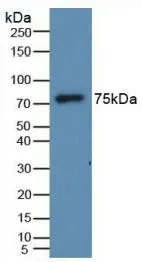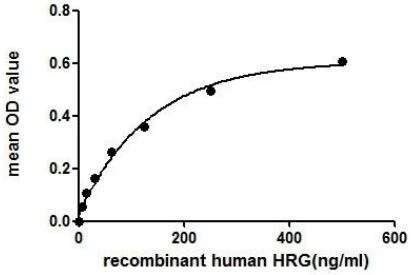
WB analysis of GTX00140-pro Human HRG protein.
Human HRG protein, His tag
GTX00140-PRO
ApplicationsFunctional Assay
Product group Proteins / Signaling Molecules
Protein IDP04196
Overview
- SupplierGeneTex
- Product NameHuman HRG protein, His tag
- Delivery Days Customer9
- Application Supplier NoteHRG (Histidine-rich glycoprotein) is a plasma glycoprotein which is distinguished by its high content of histidine and proline. HRG binds a number of ligands such as heme, heparin, heparan sulfate, thrombospondin, plasminogen, and divalent metal ions. Thus, a functional binding ELISA assay was constructed to detect the association of rhHRG with heparin. Briefly, Microtiter wells were coated with OVA-conjugated-heparin. rhHRG were diluted serially in 0.01M PBS (pH 7.4). Duplicate samples of 100 microl were then transferred to the coated microtiter wells and incubated for 2h at 37C. Wells were washed with PBST and incubated for 1h with anti-HRG PAb, then aspirated and washed 3 times. After incubation with HRP labeled secondary antibody, wells were aspirated and washed 3 times. With the addition of substrate Solution, wells were incubated 15-25 minutes at 37C. Finally, add 50 microl stop solution to the wells and read at 450nm immediately. The binding activity of rhHRG with heparin was in a dose dependent manner.
- ApplicationsFunctional Assay
- CertificationResearch Use Only
- ConjugateUnconjugated
- Protein IDP04196
- Protein NameHistidine-rich glycoprotein
- Scientific DescriptionThis histidine-rich glycoprotein contains two cystatin-like domains and is located in plasma and platelets. The physiological function has not been determined but it is known that the protein binds heme, dyes and divalent metal ions. The encoded protein also has a peptide that displays antimicrobial activity against C. albicans, E. coli, S. aureus, P. aeruginosa, and E. faecalis. It can inhibit rosette formation and interacts with heparin, thrombospondin and plasminogen. Two of the proteins effects, the inhibition of fibrinolysis and the reduction of inhibition of coagulation, indicate a potential prothrombotic effect. Mutations in this gene lead to thrombophilia due to abnormal histidine-rich glycoprotein levels. [provided by RefSeq, Nov 2014]
- Storage Instruction-20°C or -80°C,2°C to 8°C
- UNSPSC12352202



